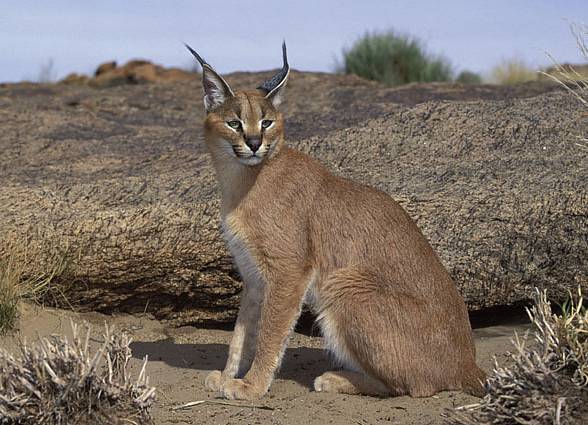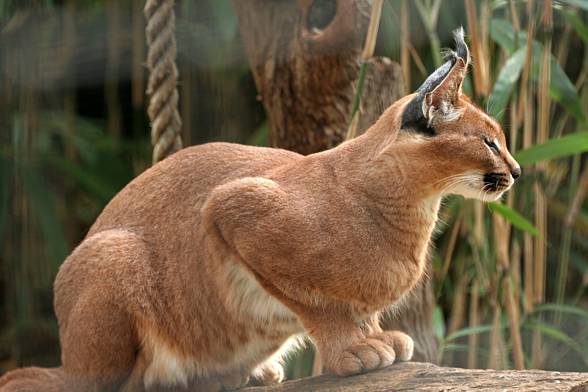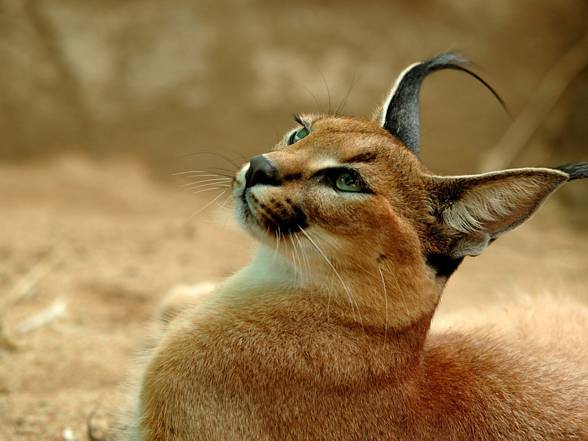Caracal – desert lynx (Caracal caracal)
The alternative name of this wild cat has not been created without a reason. It is enough to look at a caracal to see a similarity to the lynx that inhabits Eurasia. Characteristic tufts and erect ears are its hallmark and make it a desert counterpart of the Eurasian lynx, although the cats are distantly related.
Classification
- Kingdom: Animalia
- Class: Mammalia
- Order: Carnivora
- Family: Felidae
- Subfamily: Felinae
- Genus: Caracal
- Species: Caracal caracal
There are 8 subspecies of the caracal:
- Asiatic caracal (Caracal caracal poecilictis) – found in central and western Africa
- Asiatic caracal (Caracal caracal schmitzi) – found in western Asia, Iran, Saudi Arabia, and India
- Common caracal (Caracal caracal caracal) – found in central and eastern Africa
- Gabon caracal (Caracal caracal lucani) – found in Gabon, Congo, Angola
- Namibian caracal (Caracal caracal damarensis) – found in Namibia
- North African caracal (Caracal caracal algira) – found in northern Africa
- Nubian caracal (Caracal caracal nubica) – found in Ethiopia and Sudan
- Transvaal caracal (Caracal caracal limpopoensis) – found in Botswana

Name
The word caracal comes from the Turkish words “kara kulak”, which means “black ear”. In Afrikaans, the cat is called rooikat – “red cat”.
Occurrence
The caracal is commonly found in Sub-Saharan Africa, especially in the south. In central and western Africa it is a rarity. It inhabits mountainous areas near Sahara and semi-dry forested areas (savannahs, steppes). Several individuals can be seen on coastal lowlands by the Atrek, along Hari Rod and on deserts at both sides of the Murgab. The caracal lives in various areas, it prefers savannahs, scrub forests, humid forests and evergreen mountain forests.
Natural environment
- Dry savannahs
- Steppes
- Brush
- Semi-deserts

Appearance
The caracal’s build is slender, supported by long and strong legs. Coloration is tawny, reddish or sandy, plain on the back, sides of the body and outside parts of legs. Small areas on the face, the undersides and the inside part of the forelegs are an exception – white color and some black markings are predominant there.
There is also a dark stripe going along the middle of the forehead, and there are black markings below the eyes. The nose is of the color of coffee or milk chocolate. There are also melanistic individuals (completely black).
The ears are white and grey and black on the outside, and they are covered with white fluff on the inside. At the top of the ears there are long (longer than in the Eurasian lynx (Lynx lynx)), stiff tufts.
The head is relatively small, the jaws are short and equipped with strong, large teeth. The eyes are surrounded by lighter fur, but the waterline is black. Between the pads, there is long fur protecting the paws from cuts and enabling the animal to move silently. Females are slightly smaller than males.

Diet and hunting
The caracal feeds mostly on animals that weigh less than 5 kg (11 lb), including gerbils, South African springhares, and rock hyraxes. The caracal is such a capable and agile predator that it can hunt for larger prey, for example, antelopes (the goitered, springbok, common duiker, mountain reedbuck (Redunca fulvorufula), steenbok). As an animal adapted to a dry and hot climate, it can survive a long time without water.
When there is a deficit of water, it is enough for the caracal to drink body fluids of its prey.
The caracal’s talent is to jump high during hunting upon birds. On the ground it chases its prey – it approaches its prey silently for about 5 m (16 ft), and then it sprints to the prey. Smaller prey is killed by having its neck broken, larger animals have their throats bitten. If a caracal is not able to eat its prey at once, it hides the carcass among trees.

Temperament
The caracal is a hunter active day and night. If it’s too hot in the daytime, the cat prefers night-time hunting, when the temperature drops below 20oC (68oF).
Like a typical cat, the caracal is solitary, it can be sometimes seen in pairs. It produces various sounds, specific for all cats, including hissing, meowing or growling. It can also make barking-like sounds that are likely to warn others. The caracal is territorial, it marks its territory with the odor of feces left in visible places, and with urine spread on bushes.
The territory of a caracal is large: from 270 – 1100 km2 (100 to 420 mi2). On average, the territories of males are 220 km2 (85 mi2), females 57 km2 (22 mi2). The size of the area depends on the season. Males’ territories often overlap with several females’ territories. It was observed that males migrate 60-90 km (37-56 mi) south before they establish their territories, and females stay near the place of their birth. It means that the female’s territory often overlaps with the territory of her mother.
Easy to tame
In spite of appearances, the caracal is very easy to tame. The Chinese or the Egyptians were the first people who domesticated caracals. Indian people who also started to domesticate these animals took the initiative from the Chinese. While they were hunting, they dressed the caracals in leather ensembles resembling gazelles. Later, this was taken by the Mongols and Persians.
A Persian king from the Achaemenid dynasty, Cyrus the Great used to hunt using caracals. Today, there is only one people in the world who uses these animals for hunting. It inhabits the territory of southern Tajikistan (Asia).

Reproduction
The mating season lasts the whole year. In the area of Sahara, the mating season occurs mostly in the winter months. Oestrus lasts 5-6 days. Females copulate with many males in accordance with a specific order. This order, or a sort of hierarchy, is associated with the age and size of a male. Copulation is 90 seconds to 10 minutes long. Some males fight fiercely for access to a female.
The future mother hides in a cave, a tree trunk or a den dug in the ground in order to give birth away from predators. Gestation is 69-81 days long, and one litter consists of 1 to 6 kittens. Newborn caracals weigh from 198 to 250 g (7 to 9 oz). They open their eyes after 4-10 days after birth. They can leave their safe lair after about 1 month.
Their milk teeth are fully formed after 50 days, and kittens are weaned after about 10 weeks. Canines grow between the 4th and 5th month of life, and the rest of teeth grow within the next 6 months. The young stay with their mother for about 1 year until they become sexually mature.

Conservation
These wild cats are exposed to active poaching. But they are not valuable for their fur, but they are considered to be a hazard, because they often visit farms, destroying them and killing livestock.
Detailed information and measurements
Caracal / Desert lynx (Caracal caracal)
- Length:
- males: 75-105.7 cm (29.5-41.6 in), average: 78 cm (31 in)
- females: 69-102,9 cm (27-40.5 in), average: 73 cm (29 in)
- Tail length:
- males: 23,1-34 cm (9-13.4 in)
- females: 19.5-34 cm (7.6-13.4 in)
- Height at shoulders: 40-50 cm (16-20 in)
- Weight:
- males: 8-20 kg (17.6-44 lb)
- females: 7 – 15.9 kg (15.4-35 lb)
- Lifespan: to 16 years in captivity (the oldest recorded individual lived 19 years)

Caracal (desert lynx) – interesting facts
- The name “caracal” comes from Turkish kara kulak (karakulak) which means “black ear.” In Afrikaans, the cat is called rooikat – “red cat”.
- Although the caracal and the lynx have characteristic tufts on their ears, they are not closely related. The desert lynx is a close relative of the serval (Leptailurus serval/Felis serval) and African golden cat (Caracal aurata).
- The tufts on the ears are 1/2 of the ear length.
- 92% of caracals don’t have the second upper premolars.
- The desert lynx can jump up to about 2 m (6.6 ft).
- It is possible that the size of the territory – apart from the season – depends on the size of a given male, and not on the amount of food in a particular area, as it has been thought.
- A caracal female copulated with three different males and returned to them in every rooting season. The order of letting males to the female was always the same.
- The caracal is considered to be endangered in the area of northern Africa, and in republics of Central Asia and India is said to be rare. It will certainly not die out in southern Africa.
- In 1998, in the Moscow Zoo, a hybrid of a caracal and a domestic cat was made.
- The caracal played a very important role in the Ancient Egyptians’ beliefs. It has been proved by discovered paintings and sculptures, and also by embalmed bodies of these wild cats and other felids whose role after death was to guard the tomb.
- Caracal is the name of a battalion of the Israel Defense Forces.
- Caracal is the name of a city in Romania.

Recommended
- Persian leopard
- Amur leopard
- Siberian tiger
- Bengal tiger
- Sumatran tiger
- Indochinese tiger
- Malayan tiger
- South China tiger
- Tigers
- White tigers
- Lions
- White lions
- Lion vs tiger
- Liger
- Lynx
- Canada lynx
- Margay
- Serval
- Ocelot
- Animal fights
- American lion
- European cave lion
- Smilodon – Saber-toothed tiger
- Fights of animals
- Big cats
- Black panther
- Leopard
- Snow leopard
- African Lion
- Fastest animals
- Fastest birds


















